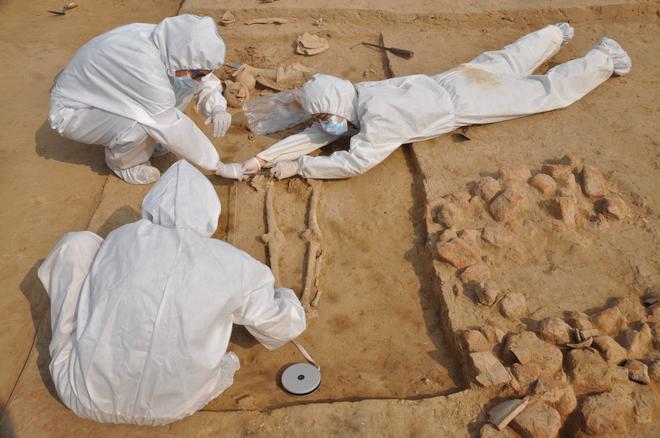"Let us be very clear, there is nothing like racial purity as every population group has got admixed over centuries in South Asia. While there is sufficient archaeological evidence that the people of the Harappan civilisation have dispersed over hundreds of years across the country towards Rajasthan, Bengal, Maharashtra, Tamil Nadu and other places, there has been no genetic study of their mixing with the people of other regional cultures, which came up later," says archaeologist-scientist Vasant Shinde, now with the CSIR-Centre for Cellular and Molecular Biology (CCMB) as the Bhatnagar Fellow.
At CCMB, the renowned archaeologist is going to take up study "for genetic mutations that have occurred over centuries among these two populations and trace the lineage". "Samples of the ancient DNA and modern-day samples collection will help us do comparative analysis to understand the population composition," explains professor Shinde, in an exclusive interaction recently at his lab.
He dismisses "controversy" over this study. "We are very clear about what we are doing. It is scientific and academic work and the evidence will be out in the public domain. There is bound to be debate when established notions about population migrations and genetic mixing are questioned, but statements should not be twisted," he avers.
Mr. Shinde, is at CCMB also because it has the facilities for extracting, analysing and sequencing the ancient DNA from skeletal remains of ancient Indians. The infrastructure is to be improved further with a new “Class 10,000“ facility for better extraction and analysis. This ‘follow up’ research will help him get into the next stage of the ground-breaking study on skeletal remains found at the Harappan site of Rakhigarhi village in Haryana under his tutelage.
From the 60 skeletal samples collected from the well-preserved cemetery in Rakhigarhi, considered to be the biggest Harappan city, ancient DNA was extracted from the remains of a young woman’s skeleton. Researchers successfully sequenced the first genome from this sample, combined it with archaeological data, which showed that these people had distinct genetic roots that originated independently.
"It can be called Lady Luck as if it was from female’s skeletal remains," chuckles the former vice chancellor of Deccan College, a PG and Research Institute in Pune, and founding director-general of the National Maritime Heritage Complex at Lothal. He points out with pride that the seminal paper published on the study was identified as among the "top nine breakthrough researches" done worldwide by the International Conference on Genomics in 2019.

"We had initiated this project at Farmana in 2006, a small Harappan town close to Rakhigarhi where the largest cemetery was excavated. We were so excited about the find and outsiders were allowed to visit the site. Later, we got to know from South Korean scientists that the ancient DNA can easily get lost or contaminated without taking precautions like wearing personal protection equipment (PPE) suits and masks. More so, the acidic soil and climatic conditions here can also play spoilsport, so there is no guarantee every skeletal remains will have the ancient DNA," he reveals.
Rakhigarhi Harappan site is spread over 550 hectares of which just 50 hectares is protected with the remaining area either having modern structures or agriculture fields. "It is a much bigger site than even Mohenjo-daro which is about 300 hectares, but we have not yet understood the composition of the population," says Mr. Shinde.
Now, the archeologist, having directed a vast number of excavations around the country, from Harappan sites in Gujarat and Haryana to Chalcolithic sites in Madhya Pradesh and the Deccan, to Protohistoric and Early Historic sites in Rajasthan and Maharashtra, intends to analyse skeletal remains of other Harappan settlements and those of contemporary regional settlements at places as diverse as Kalibangan (Rajasthan), Inamgaon (Maharastra), Sanauli (Uttar Pradesh), Ramapuram (Andhra Pradesh) another site yet to be chosen in Bengal or Bihar.
"There are over 2,000 Harappan sites spread across from Kashmir to Maharashtra, whereas its cultural influence is noticed up to Tamil Nadu. Our objective is to see how the gene mutations have taken place and changes that may have occurred. We will also need modern population samples from the people living there. Samples from Andaman and Nicobar Island tribes too will be collected as they had hardly mixed with other populations, for which we plan to take the help of the Anthropological Survey of India (AnSI)," he elaborates.
Once upgraded facilities in CCMB are ready, the first results of the DNA sequencing study of the Harappan-Regional population mix could be out in six months. "We need more modern labs for studying the DNA of ancient remains. The AnSI headquarters in Kolkata has lots of samples collected from different sites of Lothal, Kalibangan and others 50-60 years ago, but the lab needs to be modernised for archaeologists and scientists to take up deeper studies. Japan has six such labs," he points out.







